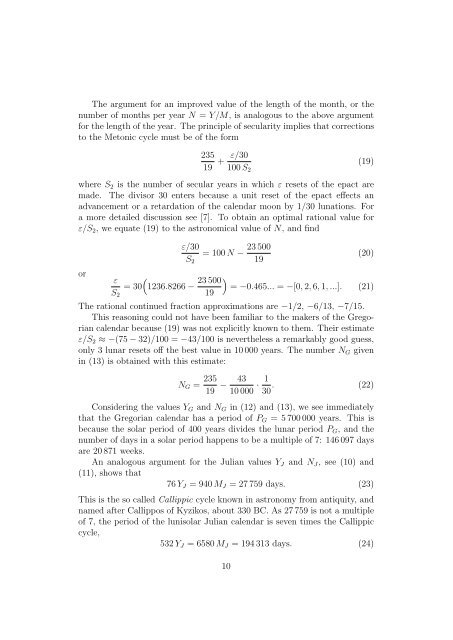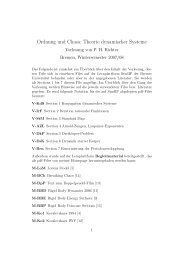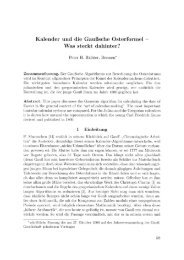The Beauty of the Gregorian Calendar
The Beauty of the Gregorian Calendar
The Beauty of the Gregorian Calendar
Create successful ePaper yourself
Turn your PDF publications into a flip-book with our unique Google optimized e-Paper software.
<strong>The</strong> argument for an improved value <strong>of</strong> <strong>the</strong> length <strong>of</strong> <strong>the</strong> month, or <strong>the</strong><br />
number <strong>of</strong> months per year N = Y/M, is analogous to <strong>the</strong> above argument<br />
for <strong>the</strong> length <strong>of</strong> <strong>the</strong> year. <strong>The</strong> principle <strong>of</strong> secularity implies that corrections<br />
to <strong>the</strong> Metonic cycle must be <strong>of</strong> <strong>the</strong> form<br />
235<br />
19<br />
+ ε/30<br />
100 S2<br />
(19)<br />
where S2 is <strong>the</strong> number <strong>of</strong> secular years in which ε resets <strong>of</strong> <strong>the</strong> epact are<br />
made. <strong>The</strong> divisor 30 enters because a unit reset <strong>of</strong> <strong>the</strong> epact effects an<br />
advancement or a retardation <strong>of</strong> <strong>the</strong> calendar moon by 1/30 lunations. For<br />
a more detailed discussion see [7]. To obtain an optimal rational value for<br />
ε/S2, we equate (19) to <strong>the</strong> astronomical value <strong>of</strong> N, and find<br />
or<br />
ε<br />
S2<br />
ε/30<br />
S2<br />
�<br />
= 30 1236.8266 −<br />
= 100 N −<br />
23 500<br />
19<br />
(20)<br />
23 500<br />
�<br />
= −0.465... = −[0, 2, 6, 1, ...]. (21)<br />
19<br />
<strong>The</strong> rational continued fraction approximations are −1/2, −6/13, −7/15.<br />
This reasoning could not have been familiar to <strong>the</strong> makers <strong>of</strong> <strong>the</strong> <strong>Gregorian</strong><br />
calendar because (19) was not explicitly known to <strong>the</strong>m. <strong>The</strong>ir estimate<br />
ε/S2 ≈ −(75 − 32)/100 = −43/100 is never<strong>the</strong>less a remarkably good guess,<br />
only 3 lunar resets <strong>of</strong>f <strong>the</strong> best value in 10 000 years. <strong>The</strong> number NG given<br />
in (13) is obtained with this estimate:<br />
NG = 235<br />
19<br />
43 1<br />
− · . (22)<br />
10 000 30<br />
Considering <strong>the</strong> values YG and NG in (12) and (13), we see immediately<br />
that <strong>the</strong> <strong>Gregorian</strong> calendar has a period <strong>of</strong> PG = 5 700 000 years. This is<br />
because <strong>the</strong> solar period <strong>of</strong> 400 years divides <strong>the</strong> lunar period PG, and <strong>the</strong><br />
number <strong>of</strong> days in a solar period happens to be a multiple <strong>of</strong> 7: 146 097 days<br />
are 20 871 weeks.<br />
An analogous argument for <strong>the</strong> Julian values YJ and NJ, see (10) and<br />
(11), shows that<br />
76 YJ = 940 MJ = 27 759 days. (23)<br />
This is <strong>the</strong> so called Callippic cycle known in astronomy from antiquity, and<br />
named after Callippos <strong>of</strong> Kyzikos, about 330 BC. As 27 759 is not a multiple<br />
<strong>of</strong> 7, <strong>the</strong> period <strong>of</strong> <strong>the</strong> lunisolar Julian calendar is seven times <strong>the</strong> Callippic<br />
cycle,<br />
532 YJ = 6580 MJ = 194 313 days. (24)<br />
10




